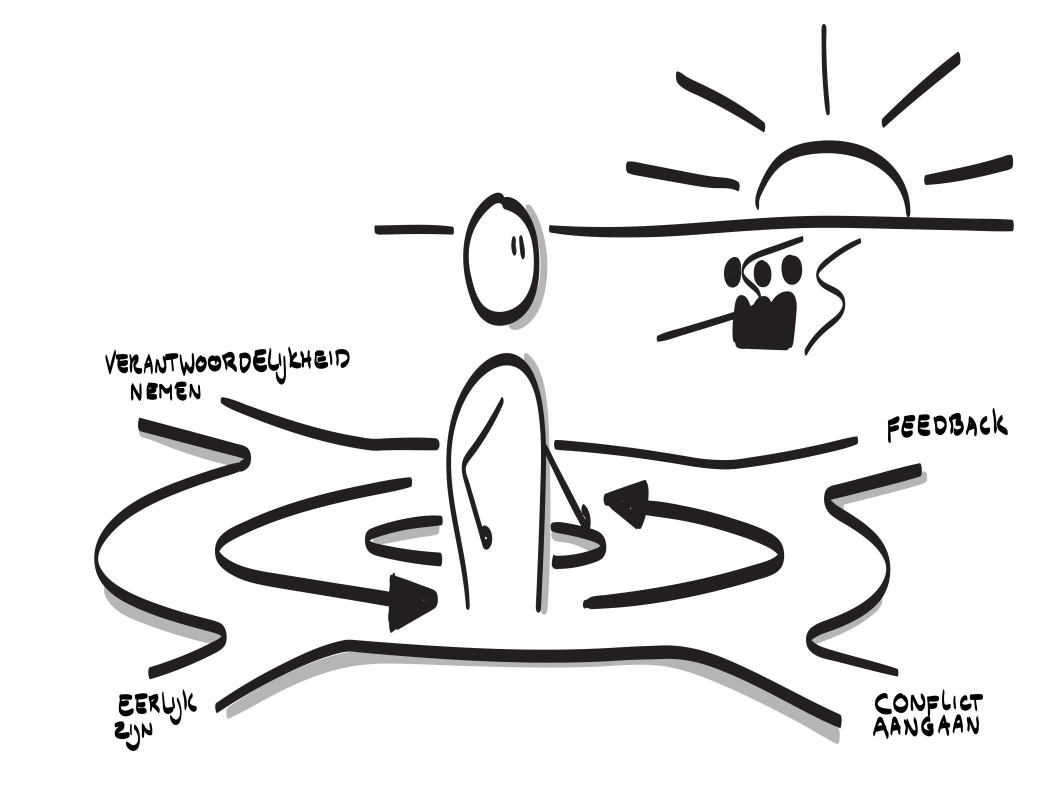The roundabout of elopement
Many teams we work with express a desire to become a truly cooperative team. But what does that require? In practice, we find that many team members beat around the bush and avoid it. They may avoid conflicts, but that's not a step towards better cooperation... Why is it that people get stuck at the roundabout of avoidance? What does it take to turn off towards good cooperation?
Wanting to belong to a group
In our blog about the threshold to a top team we already described some of the reasons why people often struggle to step up to honest feedback. This often has to do with (unconscious) assumptions that our honesty might not be appropriate or hurtful. Among other things, this has to do with a very old function of our brain: the need to be part of a group. Behaviour from us that could cause us to be placed outside the group is behaviour we unconsciously try to avoid. In the past, being outside the group also meant being outside the cave and therefore a smaller chance of struggling. Nowadays, the cave is a climate-controlled office building, but we still regularly avoid the situations in which (we think) there is a chance that with a critical attitude, we will not get a promotion or even worse lose our place in the group. And without a job but with a mortgage... how much different is that compared to outside the cave?
A danger or an opportunity?
People tend to avoid conflict. After all, we don't know what it will cost us if we confront. This causes us, for example, to gossip about someone but not give that person direct feedback or criticism. However, we then also fail to let them know what we need or find important and miss opportunities for deepening cooperation. Sometimes you do share what is needed but it seems that it is not heard, also the other person chooses elusive behaviour
Weighing an ounce
Or we just wait and see, who knows, maybe it will all resolve itself. But we also all know that many problems or awkward situations do not resolve themselves. It could be that another problem becomes more important or urgent, or that a colleague moves to another department so you no longer have to talk it out with him/her, but will that solve it? Does it make our team more skilled in struggling behaviour, avoidance behaviour or cooperation?
A hint is half the battle
On the positive side of the roundabout are the hints. "We should consult more often". Well-meaning advice to improve the situation. But not addressed directly to a person and also without concrete actions and follow-up. So chances are that hints are half-hearted and not picked up within the team or heard by the person for whom it was actually intended. After all, hints are free to be picked up or abandoned. The consequence of hints that are not followed up is disappointment or frustration on the part of the person who gave the hint, which means that you could just as soon be on the other side of the roundabout where the disappointment or frustration is shared only with others.
The advisory function of 'talking about'
'Talking about' can provide relief, relieve tension and frustration and provide advice on how to handle the situation afterwards withgoing to discuss the person. However, you only ask for advice when you want to look at possibilities with the other person: "How can I improve cooperation with Karel?"
Frustration increases when you keep difficulties central. Before you know it, it then becomes talking about the other person in the sense of 'going at it'. 'Talking about' then creates a negative atmosphere, reduces contact and becomes 'contagious'; before you know it, the annoyance is widespread.
The pointer to
In a positive sense, there are three options at the roundabout of eluding: keep driving around (thinking, seeking advice, giving hints, researching, consulting and mapping). Or turning with face the problem(setting limits, not avoiding the conflict). Or turning away with one goal in mind(talking about the task and the relationship, what is going well, what could be better, who does what and when do we evaluate it).
As you can read above, there are many opportunities and reasons to stay on the roundabout of avoiding. Sometimes we make laps in a short period of time, sometimes we stand at an exit for a bit longer. Time and again, we see in teams that it is difficult for many people to really choose a turn and be honest and give feedback, for example. On the off chance that more distance is created. Talking to the other person is then the start of a choice.
Taken a turn
It takes courage to break the circle. Courage and belief in a common goal. Identifying the problems is the second step. Speaking out what you need from the other person. And then make concrete agreements that you come back to. That gives the strength to stand up, take responsibility, take risks and achieve goals together.

